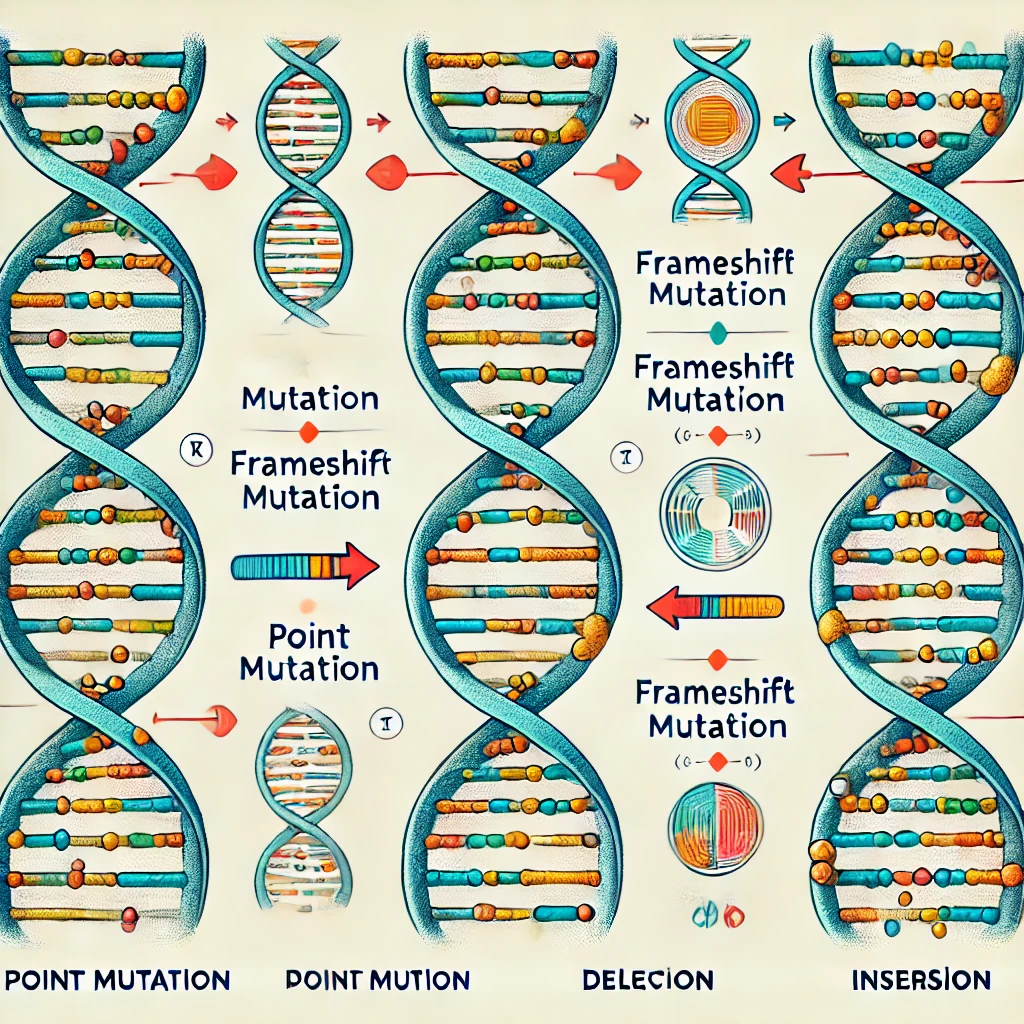Mutation in the Principles of Inheritance and Variation
The study of inheritance and variation focuses on how traits are passed from one generation to the next and how variations arise within populations. Central to this concept is mutation—an essential source of genetic diversity that fuels evolution and allows populations to adapt to their environments. This detailed explanation will cover the mechanisms of inheritance, the types and causes of mutations, their role in variation, and their impact on both organisms and evolutionary processes.

1. Understanding Inheritance and Variation
Inheritance is the process by which genetic information is passed from parents to offspring. Each organism inherits a unique combination of genetic material from both parents, leading to the expression of specific traits. Genes, located on chromosomes, contain this genetic information and exist in different forms, known as alleles, which account for variations in traits within a population.
Variation refers to the differences among individuals in a population. This diversity can result from genetic recombination during sexual reproduction or from mutations, which are changes in the DNA sequence. In addition to random mutations, environmental influences can cause genetic changes, further contributing to variation. Together, inheritance and variation allow populations to adapt to changing environments, providing a basis for evolution.
2. What is a Mutation?
A mutation is a permanent alteration in the DNA sequence of a gene or chromosome. Mutations can occur in single genes, groups of genes, or even in entire chromosomes. They are the fundamental source of new genetic material, contributing to variations that can be inherited by future generations.
Mutations occur spontaneously due to errors in DNA replication or under the influence of mutagens (external factors such as chemicals or radiation). Some mutations are harmful and lead to genetic disorders, while others are beneficial or neutral, having little effect on the organism. Mutations are the foundation of genetic diversity, essential for the adaptability and evolution of species.
3. Types of Mutations
Mutations can be classified based on the type and extent of the change in the DNA sequence.
a) Point Mutations
Point mutations affect a single nucleotide in the DNA sequence and are the simplest type of mutation. They can be further categorized into:
- Substitution: One nucleotide is replaced with another. This can lead to three types of mutations:
- Silent Mutation: The new codon still codes for the same amino acid, causing no change in the protein.
- Missense Mutation: The new codon codes for a different amino acid, potentially altering the protein’s function.
- Nonsense Mutation: The mutation creates a stop codon, leading to a shortened, often non-functional protein.
b) Frameshift Mutations
Frameshift mutations occur when nucleotides are inserted or deleted from the DNA sequence, altering the reading frame of the gene. This shift changes the sequence of amino acids in the protein, which can lead to a non-functional protein. Frameshift mutations often have severe effects on an organism.
- Insertion: One or more nucleotides are added, shifting the reading frame.
- Deletion: One or more nucleotides are removed, also shifting the reading frame.
c) Chromosomal Mutations
Chromosomal mutations involve larger segments of chromosomes and can lead to significant changes in an organism. These mutations include:
- Deletion: A section of a chromosome is lost, which may result in the loss of essential genes.
- Duplication: A portion of the chromosome is duplicated, causing multiple copies of the same gene.
- Inversion: A segment of a chromosome breaks off, reverses direction, and reattaches, potentially disrupting gene function.
- Translocation: A segment of one chromosome breaks off and attaches to another chromosome, leading to genetic disorders in some cases.
d) Germ-Line vs. Somatic Mutations
- Germ-Line Mutations: These occur in reproductive cells (sperm or egg) and are passed on to offspring, affecting future generations.
- Somatic Mutations: These occur in non-reproductive cells, affecting only the individual in which they arise and not passed to offspring. They can lead to conditions like cancer.
4. Causes of Mutations
Mutations can be caused by internal processes within cells or by external factors. Here’s a breakdown of these causes:
a) Spontaneous Mutations
These occur naturally during DNA replication or cell division, without any external influence. Errors in DNA replication can lead to point mutations, while chromosome misalignments during meiosis can cause larger chromosomal mutations. Biochemical processes, such as spontaneous base changes, can also lead to spontaneous mutations.
b) Induced Mutations
Induced mutations result from exposure to external agents, known as mutagens. Common mutagens include:
- Radiation: Ionizing radiation (e.g., X-rays) can break DNA strands, while non-ionizing radiation (e.g., UV light) can create thymine dimers, leading to replication errors.
- Chemical Mutagens: Chemicals like benzene or formaldehyde can alter DNA bases, interfering with DNA replication.
- Biological Agents: Viruses can integrate into the host genome, disrupting genes and causing mutations. For instance, some viruses are linked to cancer due to their ability to insert genetic material into human chromosomes.
5. Consequences of Mutations
The effects of mutations on organisms depend on the type and location of the mutation, as well as the genes involved.
a) Beneficial Mutations
Some mutations provide advantages in specific environments, increasing an organism’s survival or reproductive success. For example, a mutation in bacteria might confer antibiotic resistance, enhancing survival in an environment with antibiotics. These beneficial mutations can become widespread through natural selection, contributing to evolutionary adaptation.
b) Neutral Mutations
Neutral mutations have no apparent effect on the organism’s survival or reproduction. These may occur in non-coding regions of DNA or lead to silent mutations that do not change the protein sequence. Neutral mutations contribute to genetic diversity, which is important for the adaptability of populations over time.
c) Harmful Mutations
Many mutations can have negative effects on an organism, leading to diseases or disrupting normal functions. Genetic disorders like cystic fibrosis, sickle cell anemia, and Huntington’s disease are caused by mutations in specific genes. Harmful mutations can reduce an organism’s chances of survival or reproduction and may be eliminated from the population over time through natural selection.
6. Mutations and Evolution
Mutations are essential for evolution because they introduce new genetic variations, providing the raw material for natural selection. Mutations that offer a survival or reproductive advantage tend to be preserved within a population, while those that are harmful are likely to be eliminated over time.
- Adaptive Mutations: These mutations enhance an organism’s fitness, allowing it to better survive in its environment.
- Speciation: Over generations, mutations can accumulate in isolated populations, leading to the formation of new species. This process is driven by natural selection, genetic drift, and mutations.
7. Mutations in Medicine and Genetic Disorders
Mutations are central to the study of genetic disorders. Inherited mutations in germ-line cells can lead to hereditary conditions, while somatic mutations can cause diseases within the individual. Genetic disorders associated with mutations include:
- Sickle Cell Anemia: A single-point mutation changes the structure of hemoglobin, leading to sickle-shaped red blood cells.
- Cystic Fibrosis: A mutation in the CFTR gene disrupts cellular salt balance, leading to respiratory and digestive issues.
- Cancer: Mutations in tumor suppressor genes or oncogenes lead to uncontrolled cell division and tumor formation.
In medical genetics, identifying and understanding mutations allows for improved diagnosis, management, and potential treatment of genetic diseases. Gene therapy, for example, aims to correct or replace faulty genes to treat these disorders.
8. Role of Modern Genetic Research in Studying Mutations
Advances in genetics, such as CRISPR-Cas9 technology, have revolutionized our ability to study and manipulate genes. CRISPR allows scientists to make precise changes in DNA sequences, enabling studies on gene function, the effects of specific mutations, and potential therapies for genetic disorders.
Modern research focuses on identifying mutations associated with diseases, studying their impacts, and exploring genetic therapies. These advancements have the potential to transform medical treatments for conditions that were once thought incurable.
1. What is a mutation, and how does it contribute to genetic variation?
Answer: A mutation is a change in the DNA sequence of an organism’s genome. It can occur in single genes or large sections of chromosomes and can be inherited if it occurs in reproductive cells. Mutations introduce new genetic material to a population, creating diversity in traits, which is essential for evolution.
Explanation: Mutations provide new combinations of alleles, contributing to differences among individuals within a population. These genetic variations can increase the population’s adaptability to changing environments.
2. What are point mutations, and what types are there?
Answer: Point mutations are mutations that affect a single nucleotide in the DNA sequence. There are three types: silent mutations (do not change the amino acid), missense mutations (change one amino acid to another), and nonsense mutations (introduce a stop codon, truncating the protein).
Explanation: Each type of point mutation can have different impacts on protein function. Silent mutations often have no effect, while missense and nonsense mutations can significantly alter protein structure and function.
3. What is the difference between germ-line and somatic mutations?
Answer: Germ-line mutations occur in reproductive cells (sperm or eggs) and are passed to offspring, potentially affecting future generations. Somatic mutations occur in non-reproductive cells and are not inherited; they only affect the individual in which they occur.
Explanation: Germ-line mutations are significant for evolution because they add to the genetic variation in a population. Somatic mutations, while non-heritable, can lead to conditions like cancer.
4. How do frameshift mutations occur, and what impact do they have on protein synthesis?
Answer: Frameshift mutations occur when nucleotides are inserted or deleted, causing a shift in the reading frame of the genetic code. This change alters the sequence of amino acids and often results in a non-functional protein.
Explanation: Since frameshift mutations disrupt the alignment of codons, they change every amino acid downstream of the mutation, typically resulting in drastic effects on protein structure and function.
5. What role do mutations play in evolution?
Answer: Mutations introduce new genetic variations into a population, which can be acted upon by natural selection. Beneficial mutations can enhance survival and reproduction, becoming more common over generations and leading to evolutionary adaptation.
Explanation: Mutations are the raw material of evolution, creating diversity within populations. Without mutations, there would be limited genetic variation, hindering a population’s ability to adapt to new environments.
6. How are chromosomal mutations different from gene mutations?
Answer: Gene mutations affect only a single gene and involve small changes like point or frameshift mutations. Chromosomal mutations, however, involve larger segments of chromosomes, potentially affecting multiple genes and leading to deletions, duplications, inversions, or translocations.
Explanation: Chromosomal mutations often have more significant effects because they can involve large amounts of genetic material. These mutations can disrupt entire sets of genes and have severe phenotypic consequences.
7. What is a silent mutation, and why does it usually not affect the organism?
Answer: A silent mutation is a type of point mutation where a nucleotide change does not alter the amino acid sequence of a protein due to the redundancy of the genetic code. As a result, the protein’s function typically remains unaffected.
Explanation: Since many amino acids are encoded by multiple codons, a change in one nucleotide may still code for the same amino acid, meaning the protein is unchanged and the mutation has no noticeable effect.
8. What are mutagens, and how do they induce mutations?
Answer: Mutagens are agents that cause changes in DNA, increasing the frequency of mutations. They include physical factors like radiation (e.g., UV light) and chemical substances (e.g., tobacco smoke). Mutagens can cause DNA damage, leading to errors in replication and mutations.
Explanation: Mutagens can alter the chemical structure of DNA, leading to substitutions, deletions, or other changes that can become permanent mutations if not properly repaired.
9. How do mutations contribute to genetic disorders?
Answer: Some mutations disrupt the function of critical genes, leading to genetic disorders. For instance, mutations in the CFTR gene cause cystic fibrosis, while a mutation in the hemoglobin gene leads to sickle cell anemia. These mutations can impair normal cellular functions.
Explanation: Mutations in essential genes can prevent the production of functional proteins or create abnormal proteins, causing disease. Inherited mutations in specific genes are linked to various genetic disorders.
10. What is the significance of CRISPR technology in studying mutations?
Answer: CRISPR technology allows scientists to make precise changes to DNA, enabling them to study the effects of specific mutations by creating or correcting them in living organisms. This tool is essential for understanding gene function and developing gene therapies for genetic diseases.
Explanation: CRISPR’s precision and efficiency make it a valuable tool for genetic research. It has potential applications in treating genetic disorders by correcting harmful mutations directly in the patient’s genome.






